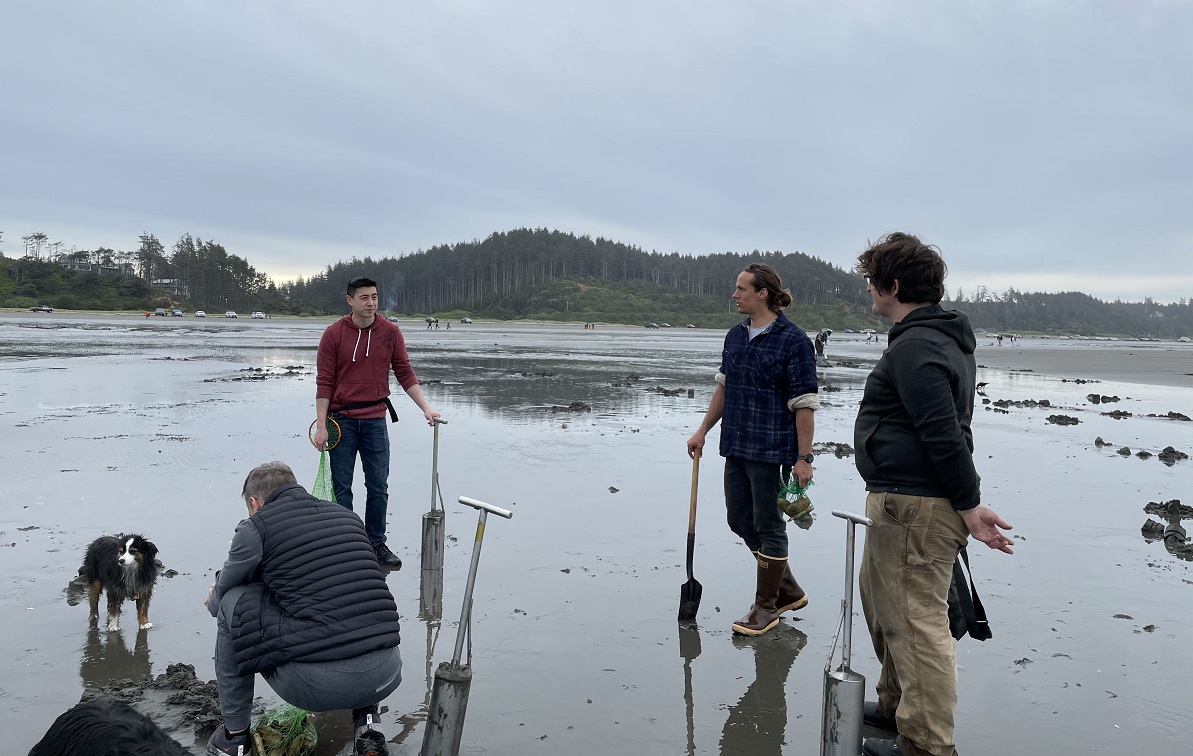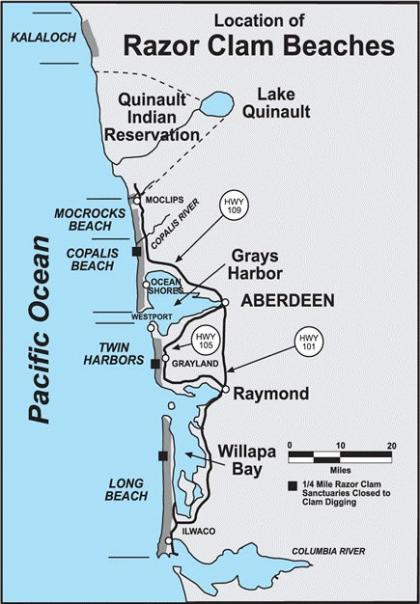Razor clam season on the Washington coast usually begins in the Fall and can go as late as May! Digging razor clams is exciting and can be done by just about anyone.
Head to our events page for the tentative digging dates: Seabrook Events
Here’s how you get started:
FIND OUT WHEN THE DIG IS HAPPENING
Check out the Washington Department of Fish and Wildlife (WDFW) for schedules and approved clam digs. The beach right below Seabrook is Mocrocks beach. Mocrocks Beach extends from the Moclips River to Copalis Rock (or the Copalis River) and the two ends of the area give it the name Mocrock. MOClips River to Copalis ROCK. The other clam beach in the area is known as Copalis and extends from the Copalis Beach area south to the North Jetty of Ocean Shores. Be sure you pay attention to which beach is open on which day as WDFW officers will enforce laws, rules, and regulations.
GET A LICENSE
The You & I Market in Pacific Beach also sells licenses and some gear. You can also get a license online at WDFW.
GEAR UP
What you wear to dig clams depends on the current weather conditions on the beach, which can transform within minutes. Gear from head to toe can include hats (waterproof, warm), scarves (wrapped to not dangle), coats, jackets, parkas, hoodies (and sometimes just a t-shirt), gloves (waterproof, grippy, warm), jeans (cuffed, rolled), pants (durable, waterproof), hip waders, chest waders, socks (long, warm), boots (rubber, waterproof, warm), and/or shoes (durable, preferably not new).
GATHER EQUIPMENT
Shovel or Clam Gun? The debate always ensues whether to use a shovel or cylinder clam gun to best dig clams. Both work well (although, besting competitions have broken out amongst families and friends).

DIG
Clams live most of their lives underwater and only low tide exposes them. Be prepared to dig at the water’s edge. To dig clams using either a shovel or cylinder clam gun, watch these videos from the WDFW, Digging Razor Clams in Washington or Digging Razor Clams with Kids in Washington.
KNOW YOUR LIMIT
Under Washington State law, diggers are allowed 15 razor clams daily and must keep the first harvested regardless of size or condition. For more information, see WDFW razor clam regulations.
CLEAN AND STORE
Here’s a great, quick-watch YouTube video on cleaning clams, How to Clean Razor Clams. Clams keep fresh cleaned and refrigerated for 3-5 days. For the longest storage life, vacuum seal your cleaned clams and freeze them which will leave them good for up to one year!
COOK
The traditional way to prepare razor clams is to batter them up with flour, egg, and crushed crackers, then pan-fry in butter. (Pro Tip: It’s easy to overcook clams, don’t go beyond golden brown!) Yummly and Betty Crocker websites have tasty recipes, along with WDFW Razor Clam Recipes submitted by fellow diggers.
ENJOY

TIPS FOR FIRST-TIME CLAM DIGGERS
- Clams live underwater and low tide is when to go! Walk as close as you are equipped to the water’s edge and look for very subtle dimple marks in the sand. You’ve found the clams! (Pro Tip: Don’t waste your time with the thousands of holes you easily see when you first walk out. Those are Sand Shrimp!)
- Keep an eye on the water. The age-old adage of “Never turn your back to the water” is never more true than during clam digging. Sneaker waves can race up the beach and knock even adults off their feet!
- Make sure you don’t go over the limit! Each licensed digger may only carry 15 clams. Anything works, but the easiest is a clam net or bag with a belt.
- For early morning or night digs, lanterns or headlamps are a must. Make sure to bring along extra batteries or backup lighting.
- Put your clams in a bucket filled with enough water to cover the clams and leave them for an hour or two. The siphoning action of the clam’s valves will purge them of sand and
- Clean the clams as soon as possible after harvesting for optimum freshness.
- Layer up! Wear boots and waterproof clothing, especially during the colder months of clam digging.
For even more razor clam digging information, visit our blog: Everything You Need To Know About Washington State Clam Digging
10 FACTS TO SHARE
- Razor clams are named for their slender shell that resembles the handle of a straight-edge razor.
- Clams and their relatives (oysters, scallops, and mussels) first appeared on earth about 510 million years ago.
- Razor clams move up and down vertically in the sand up to a foot per minute. They cannot move horizontally along the beach.
- Razor clams eat tiny plants and plankton filtered from the surrounding seawater.
- Wines that pair well with razor clam dishes are Sauvignon Blanc, Champagne, or a sparkling white wine.
- One 4 oz. serving of razor clams contains 84 calories.
- Washington State has actively managed the recreational razor clam digging since 1929.
- Approximately 2.3 million razor clams were harvested in Washington during the 2017-2018 year.
- The Washington Department of Fish and Wildlife co-manages beaches north of Grays Harbor (Copalis, Mocrocks and Kalaloch) with coastal tribes that have fishing rights. These include the Quinault Indian Nation, which has fishing rights over Copalis, Mocrocks, and Kalaloch beaches and the Hoh Tribe and the Quileute Tribe with fishing rights over Kalaloch beach.
- Washington lawmakers are considering whether to make razor clams the state’s “official clam.”
Sources: Summaries of numerous corroborative websites.
